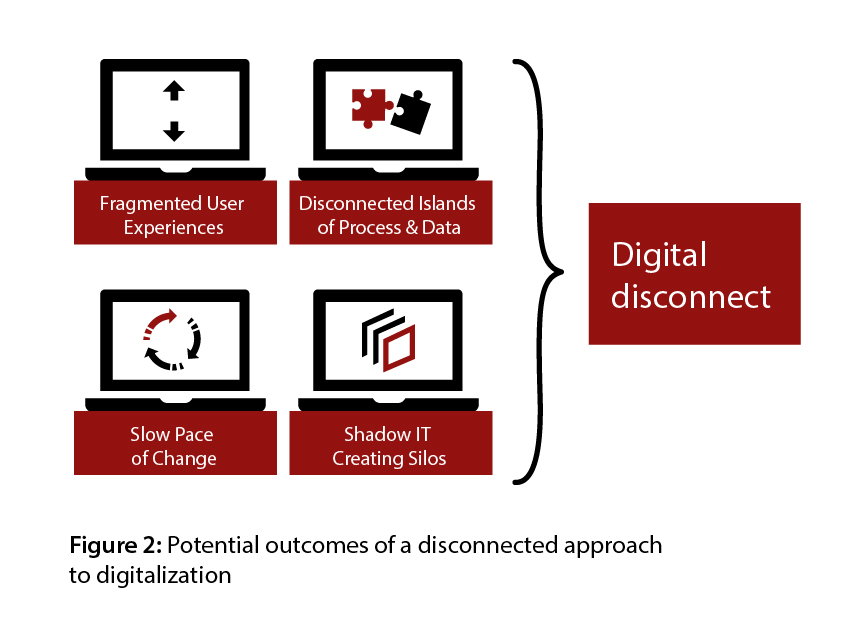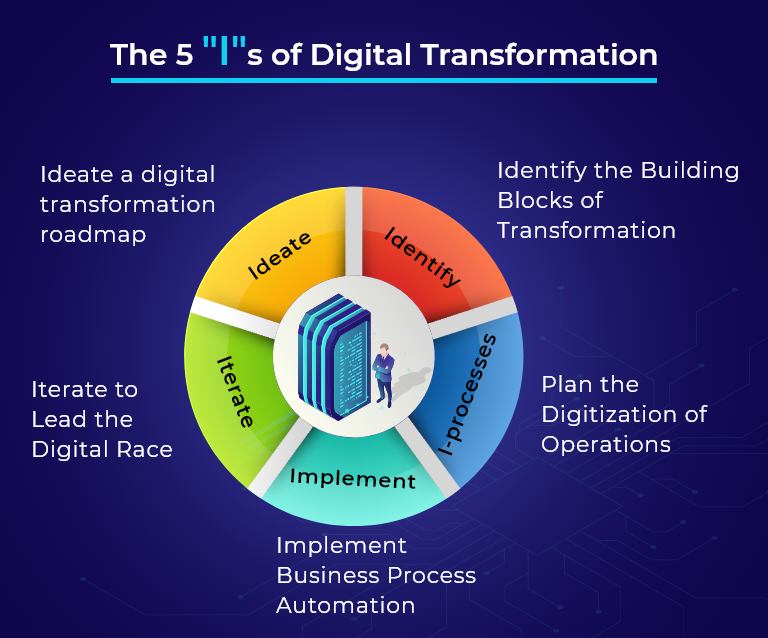Around the world, CXOs of many organizations have expressed that the timeline for going digital has shrunk from 4-5 years to 6-12 months. In today’ accelerated time frame, strategy and approach hold cardinal import, as the organization’s future in the new normal hinges on the success of its digital ambitions and innovation appetite.
Most businesses stand optimized for a semi-digital world, however in their effort to go digital they find themselves investing erratically to new technology. Although Digital Transformation (DX) sounds like a complete overhaul of company infrastructure aimed at upgrading everything, from legacy systems to business models, a sudden transition to completely transform your company’s digital landscape and complete digital transformation can prove extremely risky.
Various research findings reveal that only a third of DX efforts fail, in 2018 alone around $ 900 billion were invested in DX attempts that failed. It is thus, a risky process to say the least
Ipso facto, for a majority of companies a piecemeal approach, which aims at transforming small and specific items, may work better.
Mind These Major Roadblocks

Firms must refrain from pursuing an unbalanced approach, addressing one aspect in isolation– such as generating new user experiences or isolated process automation. This would simply create a bunch of digital disconnects, with process silos between new and old systems.
We also recommend a shift from the usual practice of using process automation platforms to automate processes, as they are. Optimization of processes before they are digitized is the most crucial step.
Also, there must be a digital transformation roadmap and a visualization of the final end. It is for these reasons that we recommend getting engaged in long term with a technology partner with experience and who can ensure success of the endeavour.
The need is thus to engage with technology partners who can take ownership of the outcomes of DX exercise, and not just pitch in technology.
To dampen the risks associated with DX, we recommend The 5 “I”s of digital transformation:
- Ideate a digital transformation Roadmap
- Identify the Building Blocks of Transformation
- I-processes: Plan the Digitization of Operations
- Implement Business Process Automation
- Iterate to Lead the Digital Race

1. Ideate a digital transformation roadmap
The extent of digital transformation is influenced by diverse factors such as the industry, organisational size and age, volume of legacy systems and processes which require transformation, and objective of the exercise.
- Visualize and Articulate the End State
How much transformation are you trying to achieve; how much is “good enough”. Think straight; conceive the impacts on products, processes, productivity and on profitability. - Fashion Your Strategy & Timelines
How long should it take?
Will you go for one big leap or piecemeal?
What are the key areas of change? And More!
Work with your technology partner to chalk out an optimal strategy. - Prioritize Your Key Areas of Change
The flow must be well thought out; prioritize key areas within the timeline and in proper sequence. You can decide based on likelihood of success or the impact it will have.
2. Identify the Building Blocks of Transformation
Sit and plan with your technology partner, how best to apply the piecemeal approach. Plan small and separate transformations, but in a way that it remains synchronous with the organisational whole. Avoid Silos at all costs.
3. I-processes: Plan the Digitization of Operations
For many firms digital transformation means digitization, but when done without an organisational vision, the endeavour may create a new pandora’s box.
Here are a few simple steps to follow for maximum benefit.
Step 1: Analyze Existing Operations
Conduct a comprehensive appraisal of the entire organizational workflow and processes.
Step 2: Identify Most Suitable Processes
Once processes are mapped, identify and prioritize the process to begin digitization. The most repetitive, routine, and manual processes which have an impact on cost, time, and customer are a great starting point for enterprise digitization. Process requiring re-engineering could be worked upon at later stages or in the later iterations of piecemeal transformation.
Step 3: Initiate Digitization of Select Processes
Map the select processes for their bottlenecks, and identify areas of conflict with other processes. Once sorted, use an apt technology platform to digitize the processes.
4. Implement Business Process Automation
Digitized processes can be integrated into a suitable, versatile and advanced platform which automates the workflow by controlling the flow of information across platforms.
A smooth information and workflow eliminates inefficiencies in operating models. A well structured format of routine tasks, when automated, unlock a significant amount of value as it saves time, reduces errors, expedites processes and creates data which upon analysis, can give critical insights. Here is how to do it:
- Identify the processes that need to be automated
- Brainstorm on the objectives and tangible efficiency gains and peg a budget
- Choose a technology that is affordable, meets objectives, is scalable and future ready
- Measure efficiency and productivity gains
Process automation is that essential step which frees human labour to focus on high-value tasks.
5. Iterate to Lead the Digital Race
Digital Transformation is a journey not a destination.
Though a successful transformation entitles the firm and its people to rewards, but the destination oriented myopia may prove fatal. Many iterations would only make the company digital enough to stand any test of the day, but then it must also think of the change the future may usher in.
For successful transformation, roadmap and strategy might not suffice as there are many facets of DX. As leaders driving the change, you must be aware of cardinal principles of transformation.
We have written a comprehensive White Paper that throws light on digital strategies and tactics that can help you to build the next-gen digital enterprise that thrives in the post pandemic world.
Get your free copy – Digital Transformation Strategies to Thrive in Post Pandemic World.
 All Posts
All Posts


